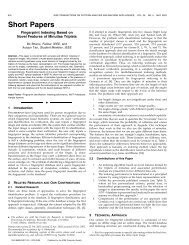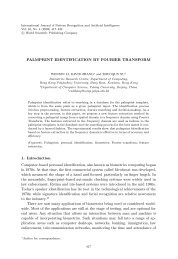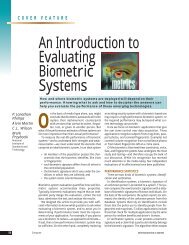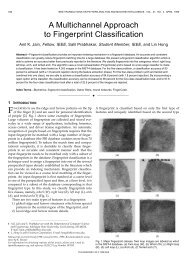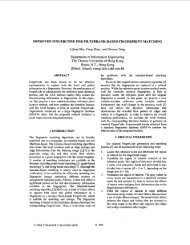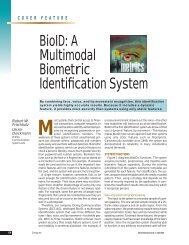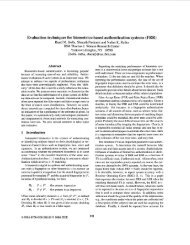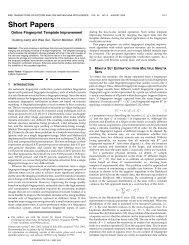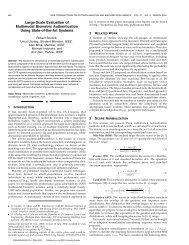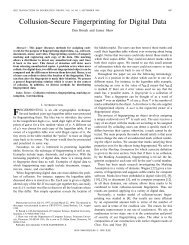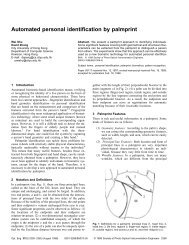Real-time embedded face recognition for smart home ... - IEEE Xplore
Real-time embedded face recognition for smart home ... - IEEE Xplore
Real-time embedded face recognition for smart home ... - IEEE Xplore
Create successful ePaper yourself
Turn your PDF publications into a flip-book with our unique Google optimized e-Paper software.
190<br />
VII. CONCLUSION<br />
In this paper, we have presented a fast <strong>embedded</strong> <strong>face</strong><br />
<strong>recognition</strong> system <strong>for</strong> <strong>smart</strong> <strong>home</strong> applications. In contrast<br />
with highly constrained <strong>face</strong> <strong>recognition</strong> under consistent<br />
environments, our proposal concentrates on robust real-life<br />
<strong>recognition</strong> under unconstrained environments. Furthermore,<br />
processing efficiency and low-cost are our major concerns. To<br />
meet these requirements, we developed a pipeline of <strong>face</strong><br />
processing algorithms, namely, <strong>face</strong> detection, facial feature<br />
extraction <strong>for</strong> <strong>face</strong> normalization, and <strong>face</strong> identification.<br />
During each processing stage, we use step-wise refinements<br />
<strong>for</strong> improved robustness and efficiency. The system has<br />
achieved over 95% <strong>recognition</strong> rate and 3-4 frames/sec.<br />
processing speed.<br />
Our proposed <strong>face</strong> <strong>recognition</strong> system has a relatively<br />
unconstrained operation environment and offers high<br />
processing efficiency using low-cost hardware. This is<br />
especially attractive <strong>for</strong> consumer <strong>home</strong> applications, where<br />
easy user inter<strong>face</strong>s and low expenses are of most interest. In a<br />
distributed version of the <strong>face</strong> <strong>recognition</strong> system, the <strong>face</strong><br />
processing pipeline is distributed over a number of different<br />
processing units. The distribution may be such that expensive<br />
computations are per<strong>for</strong>med by units that have ample<br />
computation power, so that the overall processing cost is<br />
reduced considerably. For example, in a surveillance<br />
application, <strong>face</strong> detection is done at the <strong>home</strong> entrance, and<br />
the feature extraction and <strong>face</strong> identification is carried out on a<br />
media server in the <strong>home</strong>.<br />
The current HomeFace system is able to handle (near) frontview<br />
<strong>face</strong>s with out-of-plane rotation within ± 20 degrees.<br />
Larger head-pose variations are not considered in the<br />
<strong>recognition</strong>. Future research is still required to handle large<br />
head rotations to facilitate more natural user inter<strong>face</strong>s.<br />
ACKNOWLEDGMENT<br />
The authors would like to thank Frank van Tuijl and Peter<br />
van Grinsven from Philips Research Labs. Eindhoven <strong>for</strong> their<br />
support <strong>for</strong> the integration of the HomeFace <strong>face</strong> <strong>recognition</strong><br />
system into the HomeNet2Run demonstrator.<br />
REFERENCES<br />
[1] A. Pentland and T. Choudhury, “Face <strong>recognition</strong> <strong>for</strong> <strong>smart</strong><br />
environments”', <strong>IEEE</strong> Computer, vol. 33, no. 2, pp. 50-55, Feb. 2000.<br />
[2] HomeNet2Run project website, http://www.extra.research.philips.com/<br />
euprojects/hn2r/.<br />
[3] W. Zhao, R. Chellappa, P.J. Philips and A. Rosenfeld, “Face<br />
<strong>recognition</strong>: A literature survey”, ACM Computing Surveys, Vol. 35, no.<br />
4, pp. 399-458, Dec. 2003.<br />
[4] M.-H. Yang, D. Kriegman, and N. Ahuja, “Detecting <strong>face</strong>s in images: A<br />
Survey”, <strong>IEEE</strong> Trans. on Pattern Analysis and Machine Intelligence,<br />
vol. 24, no. 1, pp. 34-58, 2002.<br />
[5] J. Yang, W. Lu and A. Waibel, “Skin-color modelling and adaptation”,<br />
Proc. ACCV, pp. 687-694, 1998.<br />
[6] Y. Ma and X. Ding, “Face detection based on hierarchical Support<br />
Vector Machines”, Proc. ICPR, pp. 222-225, 2002.<br />
[7] F. Zuo and P.H.N. de With, “Fast human <strong>face</strong> detection using<br />
successive <strong>face</strong> detectors with incremental detection capability”, Proc.<br />
SPIE, Electronic Imaging 2003, vol. 5022, pp. 831-841, Jan. 2003.<br />
<strong>IEEE</strong> Transactions on Consumer Electronics, Vol. 51, No. 1, FEBRUARY 2005<br />
[8] H. Rowley, S. Balujua and T. Kanade, “Neural network-based <strong>face</strong><br />
detection”, <strong>IEEE</strong> Trans. On Pattern Analysis and Machine Intelligence,<br />
vol. 20, no. 1, pp. 23-28, 1998.<br />
[9] P.J. Phillips, H. Moon, S.R. Rizvi and P.J. Rauss, “The FERET<br />
evaluation methodology <strong>for</strong> <strong>face</strong> <strong>recognition</strong> algorithms”, <strong>IEEE</strong> Trans.<br />
PAMI, Vol. 22, pp. 1090-1104, 2000.<br />
[10] A. Yuille and P.W. Hallinan and D. Cohen, “Feature extraction from<br />
<strong>face</strong>s using de<strong>for</strong>mable templates”, Int. Journal Computer Vision, Vol.<br />
8, pp. 99-112, 1992.<br />
[11] T. Cootes, “Statistical models of appearance <strong>for</strong> computer vision”, Tech.<br />
Rep., Univ. of Manchester, 2001.<br />
[12] F. Zuo and P.H.N. de With, “Fast facial feature extraction using a<br />
de<strong>for</strong>mable shape model with Haar-wavelet based local texture<br />
attributes”, Proc. ICIP, pp. 1425-1428, 2004.<br />
[13] B. Froba and C. Kublbeck, “<strong>Real</strong>-<strong>time</strong> <strong>face</strong> detection using Edge-<br />
Orientation Matching”, Proc. AVBPA, pp. 78-83, 2001.<br />
[14] P. Viola and M. Jones, “Rapid object detection using a boosted cascade<br />
of simple features”, Proc. CVPR, pp. 511-518, 2001.<br />
[15] A.M. Martinez and R. Benavente, “The AR Face Database”, CVC Tech.<br />
Rep. #24, 1998.<br />
[16] M. Turk and A.P. Pentland, “Face <strong>recognition</strong> using Eigen<strong>face</strong>s”, Proc.<br />
CVPR, pp. 586-591, 1991.<br />
[17] P.N. Belhumeur, J.P. Hespanha, and D.J. Kriegman, “Eigen<strong>face</strong>s vs.<br />
Fisher<strong>face</strong>s: Recognition using class-specific linear projection”, <strong>IEEE</strong><br />
Trans. PAMI, vol. 19, No. 7, pp. 711-720, July 1997.<br />
Fei Zuo received both her B.Eng. and M.Sc. in<br />
computer science from Xi'an Jiaotong University, P.<br />
R. China. In 2001, she became a Ph.D student in the<br />
VCA (Video Coding and Architectures) group at<br />
Electric Engineering Depart., Eindhoven University of<br />
Technology, The Netherlands. Her research interests<br />
include <strong>face</strong> detection and <strong>recognition</strong>, object<br />
extraction and classification. From 2001-2003, she<br />
was involved in the ITEA project HomeNet2Run and<br />
worked on <strong>embedded</strong> <strong>face</strong> <strong>recognition</strong>. Since 2004, she is also cooperating<br />
with System Identification Technology group at Philips Research Labs. At<br />
Eindhoven and contributes to biometric template protection on <strong>face</strong><br />
<strong>recognition</strong>.<br />
Peter H.N. de With graduated in electrical<br />
engineering from the University of Technology in<br />
Eindhoven. In 1992, he received his Ph.D. degree<br />
from the University of Technology Delft, The<br />
Netherlands, <strong>for</strong> his work on video bit-rate reduction<br />
<strong>for</strong> recording applications. He joined Philips Research<br />
Labs Eindhoven in 1984, where he became a member<br />
of the Magnetic Recording Systems Department. From<br />
1985 to 1993, he was involved in several European<br />
projects on SDTV and HDTV recording. In this<br />
period, he contributed as a principal coding expert to the DV standardization<br />
<strong>for</strong> digital camcording. In 1994, he became a member of the TV Systems<br />
group at Philips Research Eindhoven, where he was leading the design of<br />
advanced programmable video architectures. In 1996, he became senior TV<br />
systems architect and in 1997, he was appointed as full professor at the<br />
University of Mannheim, Germany, at the faculty Computer Engineering. In<br />
Mannheim he was heading the chair on Digital Circuitry and Simulation with<br />
the emphasis on video systems. Since 2000, he is with CMG Eindhoven (now<br />
LogicaCMG) as a principal consultant and he is professor at the University of<br />
Technology Eindhoven, at the faculty of Electrical Engineering. He has<br />
written and co-authored numerous papers on video coding, architectures and<br />
their realization. Regularly, he is a teacher of the Philips Technical Training<br />
Centre and <strong>for</strong> other post-academic courses. In 1995 and 2000, he coauthored<br />
papers that received the <strong>IEEE</strong> CES Transactions Paper Award, and<br />
in 2004, the SPIE Investigators Award. In 1996, he obtained a company<br />
Invention Award. In 1997, Philips received the ITVA Award <strong>for</strong> its<br />
contributions to the DV standard. Mr. de With is a senior member of the<br />
<strong>IEEE</strong>, program committee member of the <strong>IEEE</strong> CES and ICIP, chairman of<br />
the Benelux community <strong>for</strong> In<strong>for</strong>mation and Communication Theory, coeditor<br />
of the historical book of this community, <strong>for</strong>mer scientific board<br />
member of CMG, scientific advisor of the Dutch Imaging school ASCII, <strong>IEEE</strong><br />
ISCE and board member of various working groups.



